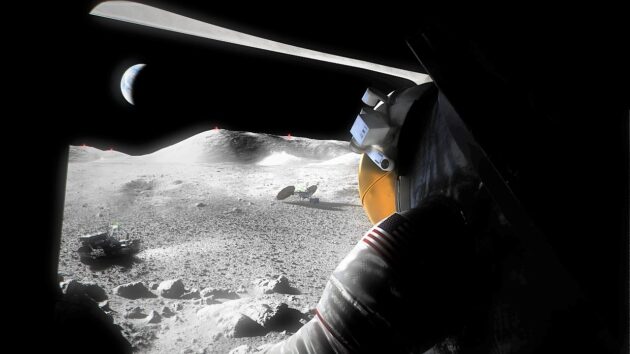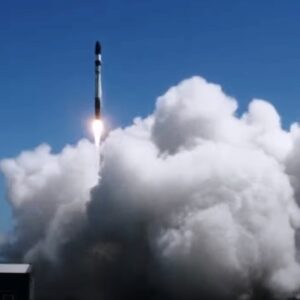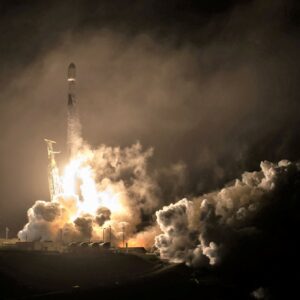
NASA has laid out its plan for choosing a second commercial venture to build a landing system capable of carrying astronauts to and from the lunar surface.
The venture would provide a competitive alternative to SpaceX’s lunar landing system, which is based on its Starship design and won a $2.9 billion NASA contract last April. The Starship lunar lander is scheduled to take on an uncrewed test mission to the moon in 2024, followed by the first crewed lunar landing for NASA’s Artemis program in 2025.
“We expect approximately one human landing per year, over a decade or so, and these are not isolated missions,” NASA Administrator Bill Nelson said today. “Each is going to build on the past progress. … And all of that is, of course, in preparation for us then to have the first human mission to Mars late in the 2030s or 2040.”
When SpaceX won NASA’s nod last April, two competitors for the contract — Alabama-based Dynetics and a team led by Jeff Bezos’ Blue Origin space venture — complained that NASA should have made more than one award, in the interest of promoting competition. Some members of Congress, including Sen. Maria Cantwell, D-Wash., made similar arguments.
Nelson said the new program, known as the Sustaining Lunar Development contract or NextSTEP Appendix P, would address those complaints. “I promised competition, so here it is,” he told reporters.
If the program proceeds according to plan, the second company’s landers would go into service in the 2026-2027 time frame, starting with an uncrewed test mission to the lunar surface.
The new program follows up on a $146 million effort called NextSTEP Appendix N, which is paying five companies to fine-tune their plans for crewed lunar landers and reduce future technical risks. Blue Origin is part of that effort — as are Lockheed Martin and Northrop Grumman, two of its partners in the “National Team” that was behind the initial lunar lander proposal. SpaceX and Dynetics are also participating in Appendix N.
Blue Origin and its National Team partners, as well as Dynetics, will presumably put in proposals for the second contract. In an emailed response to GeekWire’s inquiry, a Blue Origin spokesperson said the company was “thrilled that NASA is creating competition by procuring a second human lunar landing system.”
“By doing so, NASA will establish the critical redundancy and robustness needed for establishing permanent U.S. lunar presence,” the spokesperson wrote. “Blue Origin is ready to compete and remains deeply committed to the success of Artemis. We will continue to work with NASA to achieve the United States’ goal to return to the moon as soon as possible.”
SpaceX, which is said to be on track with its plans for the lunar Starship, won’t be eligible to bid for the second contract. Instead, NASA will negotiate with SpaceX to upgrade Starship for missions following up on the first landing, in accordance with provisions under Option B of NextSTEP Appendix H. (SpaceX’s initial contract was awarded under Option A.)
The new specifications will boost the requirements for crew landing capacity beyond the initial two-astronaut configuration. Capabilities for carrying cargo and science instruments will be boosted as well. Still more upgrades would make it possible for the lander to stay on the lunar surface longer than the six days currently called for, said Lisa Watson-Morgan, program manager for the Human Landing System Program at NASA’s Marshall Space Flight Center.
NASA’s original lunar lander concept envisioned as many as three separate spacecraft elements — including a moon-orbiting transfer vehicle, a descent module and an ascent module. Based on the Appendix N discussions, that three-element architecture would no longer be a requirement, Watson-Morgan said. However, the lander would have to be capable of docking with the Gateway space platform that NASA envisions putting into lunar orbit.
NASA officials held back for now on providing dollar figures for the new lunar lander program. Nelson said details on proposed spending for fiscal year 2023 “should be coming next week.”
Watson-Morgan said a draft request for proposals would be issued by the end of March, with a final version released this spring. She said the award should be made at the “onset of the new year … or shortly thereafter.”
Last year, NASA’s lunar lander award to SpaceX set off a months-long legal wrangle with Blue Origin’s team — but James Free, NASA’s associate administrator for exploration systems development, said last November’s resolution of the dispute validated NASA’s approach to the competition. He also said the Appendix N process should lead to lower bids for future lunar landers.
“Many folks have told us, ‘Hey, you know, we’ve learned a lot, and we think our bids can be better this time,’” Free said.
On related topics:
- Watson-Morgan said SpaceX “has met all their milestones to date” for the development of the lunar Starship, although she acknowledged that increasingly challenging milestones — such as Starship’s first orbital launch — lie ahead. “We’re working deeply with them to make sure we have the right risk-based insight that’s needed. … There are some potential areas that we’re watching out for,” she said.
- Even under the newly announced programs, astronauts would be sent from Earth to lunar orbit using NASA’s Orion capsule and Space Launch System rocket, Nelson said. The SLS rocket is due to be launched for the first time in the May-June time frame for an uncrewed round-the-moon mission. Nelson noted that a more powerful version of the SLS is due to become available for launch after Artemis’ first crewed lunar landing. “That’s the only difference in the architecture,” Nelson said.
- In response to a question about the war in Ukraine and its effect on the International Space Station partnership with Russia, Nelson said that the “professional relationship between the astronauts and cosmonauts aboard the station, as well as the professional relationship between Mission Control in both Houston and Moscow, continues unaltered.” He said he expected the return of NASA astronaut Mark Vande Hai aboard a Russian Soyuz spacecraft, scheduled for later this month, to take place “without a hitch.”





